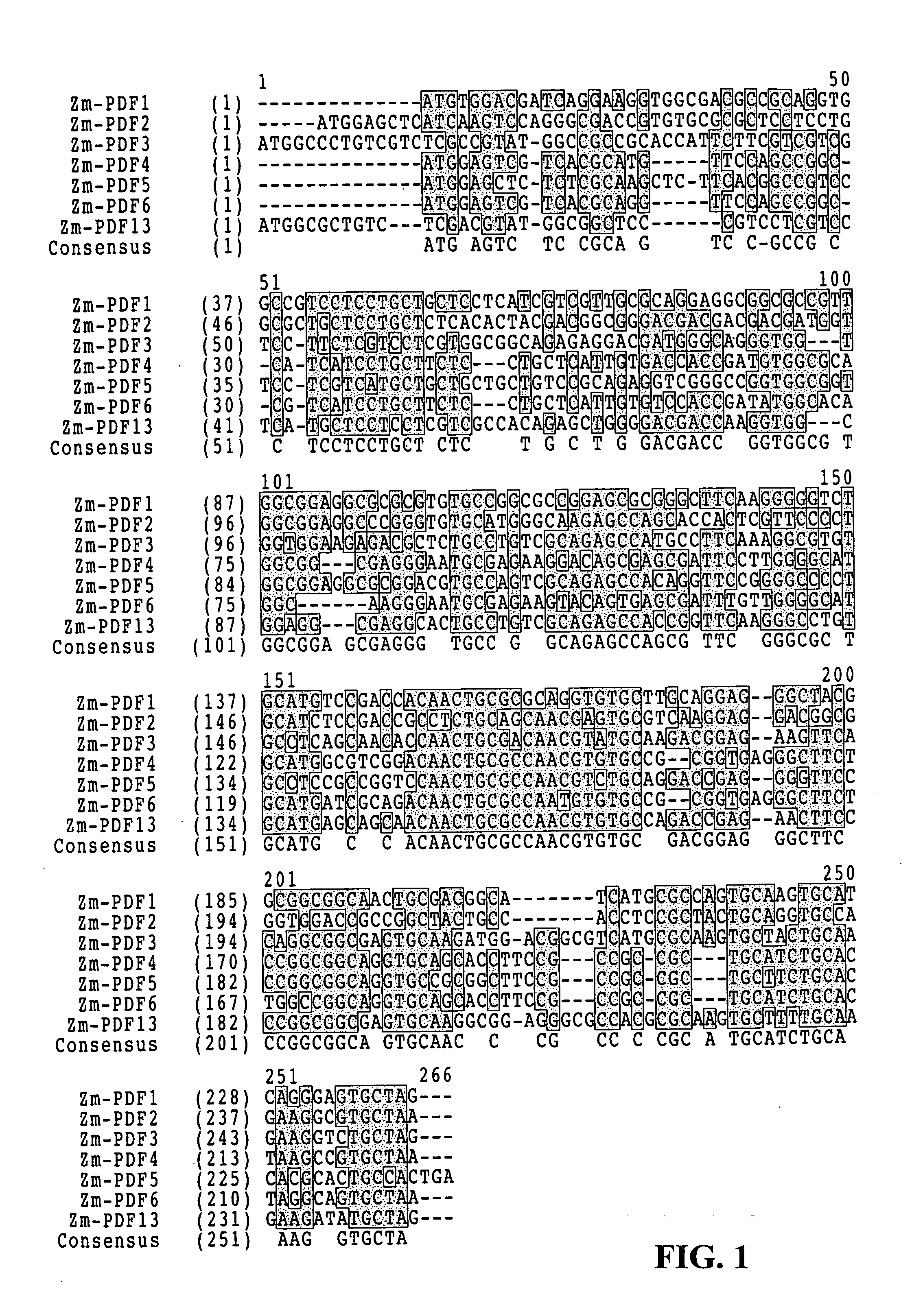Defensin polynucleotides and methods of use
a technology of defensin and polynucleotides, which is applied in the field of gene activity and development in plants, can solve the problems of limited host range, major social change, and the possibility of serious crop disease epidemics that persist today, and achieve the effect of enhancing the resistance to plant pathogens and the defense system of plant pathogens
- Summary
- Abstract
- Description
- Claims
- Application Information
AI Technical Summary
Problems solved by technology
Method used
Image
Examples
example 1
Transformation and Regeneration of Transgenic Plants in Maize
[0218] Immature maize embryos from greenhouse donor plants are bombarded with a plasmid containing a defensin nucleotide sequence of the invention operably linked to a ubiquitin promoter and the selectable marker gene PAT (Wohlleben et al. (1988) Gene 70:25-37), which confers resistance to the herbicide Bialaphos. Alternatively, the selectable marker gene is provided on a separate plasmid. Transformation is performed as follows. Media recipes follow below.
Preparation of Target Tissue
[0219] The ears are husked and surface sterilized in 30% Clorox bleach plus 0.5% Micro detergent for 20 minutes, and rinsed two times with sterile water. The immature embryos are excised and placed embryo axis side down (scutellum side up), 25 embryos per plate, on 560Y medium for 4 hours and then aligned within the 2.5-cm target zone in preparation for bombardment.
Preparation of DNA
[0220] A plasmid vector comprising a defensin nucleotid...
example 2
Agrobacterium-Mediated Transformation in Maize
[0230] For Agrobacterium-mediated transformation of maize with a defensin nucleotide sequence of the invention operably linked to a ubiquitin promoter, preferably the method of Zhao is employed (U.S. Pat. No. 5,981,840, and PCT patent publication WO98 / 32326; the contents of which are hereby incorporated by reference). Briefly, immature embryos are isolated from maize and the embryos contacted with a suspension of Agrobacterium, where the bacteria are capable of transferring the DNA construct containing the defensin nucleotide sequence to at least one cell of at least one of the immature embryos (step 1: the infection step). In this step the immature embryos are preferably immersed in an Agrobacterium suspension for the initiation of inoculation. The embryos are co-cultured for a time with the Agrobacterium (step 2: the co-cultivation step). Preferably the immature embryos are cultured on solid medium following the infection step. Follow...
example 3
Soybean Embryo Transformation
[0231] Soybean embryos are bombarded with a plasmid containing the defensin nucleotide sequences operably linked to a ubiquitin promoter as follows. To induce somatic embryos, cotyledons, 3-5 mm in length dissected from surface-sterilized, immature seeds of the soybean cultivar A2872, are cultured in the light or dark at 26° C. on an appropriate agar medium for six to ten weeks. Somatic embryos producing secondary embryos are then excised and placed into a suitable liquid medium. After repeated selection for clusters of somatic embryos that multiplied as early, globular-staged embryos, the suspensions are maintained as described below.
[0232] Soybean embryogenic suspension cultures can be maintained in 35 ml liquid media on a rotary shaker, 150 rpm, at 26° C. with florescent lights on a 16:8 hour day / night schedule. Cultures are subcultured every two weeks by inoculating approximately 35 mg of tissue into 35 ml of liquid medium.
[0233] Soybean embryogen...
PUM
| Property | Measurement | Unit |
|---|---|---|
| temperature | aaaaa | aaaaa |
| temperature | aaaaa | aaaaa |
| pH | aaaaa | aaaaa |
Abstract
Description
Claims
Application Information
 Login to View More
Login to View More - R&D
- Intellectual Property
- Life Sciences
- Materials
- Tech Scout
- Unparalleled Data Quality
- Higher Quality Content
- 60% Fewer Hallucinations
Browse by: Latest US Patents, China's latest patents, Technical Efficacy Thesaurus, Application Domain, Technology Topic, Popular Technical Reports.
© 2025 PatSnap. All rights reserved.Legal|Privacy policy|Modern Slavery Act Transparency Statement|Sitemap|About US| Contact US: help@patsnap.com

